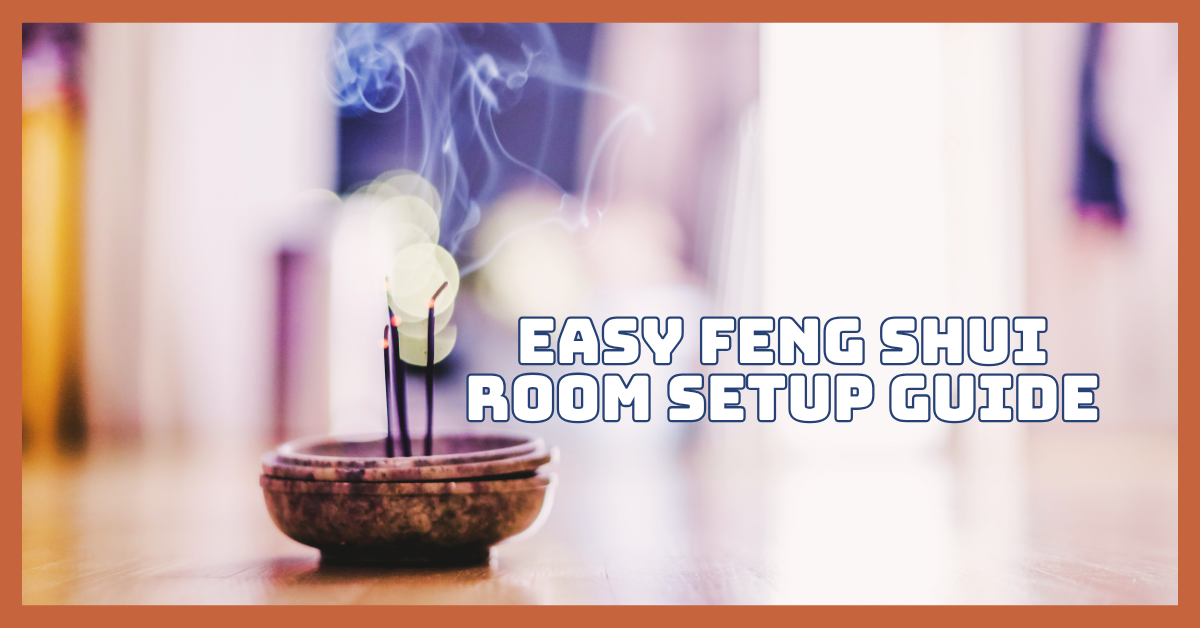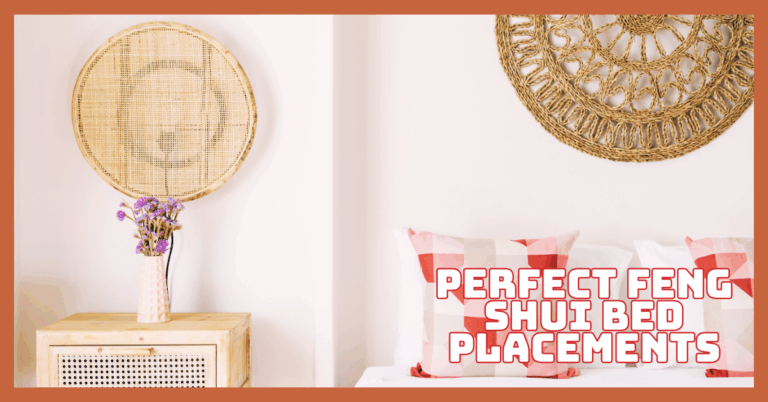Easy Feng Shui Room Setup Guide
A well-designed living space can bring harmony and positive energy into your life. You can create a calm space that encourages success and relaxation with a few easy tweaks and careful placement.
Whether you’re new to this practice or want to refresh your home’s vibe, this guide offers easy tips to help you transform any room.
Discover how a proper Feng Shui Room Setup can uplift your daily life.
Easy Feng Shui Room Setup Guide
Feng Shui Living Room Setup
Creating a Feng Shui living room is all about balance, harmony, and positive energy flow. Create a calm, inviting haven in your home by carefully placing furniture, utilizing deliberate colour schemes, and adding natural accents.
Here’s how to set up your living room for optimal Feng Shui.
1. Furniture Placement
Arrange your living room seating in a circular or square layout to encourage inclusive conversation and optimal energy circulation.
Furniture should not be positioned with its back to windows or doors, as this disturbs the flow of Qi (energy). Symmetry in furniture arrangement promotes harmony among those who gather.
Include a central coffee table to ground the space. Ensure there’s ample room to move comfortably, reinforcing openness and flow. This setup supports relationship-building and helps create a warm, connected, and inviting social environment.
2. Command Position
The command position enhances a sense of security and control. The main sofa should be oriented toward the entrance door, but not immediately in front of it.
This placement allows you to see who enters the room, offering subconscious reassurance and stability. If positioning the sofa this way is not possible, add a mirror that reflects the door.
Avoid sitting with your back exposed to an entry. This arrangement promotes safety, visibility, and comfort, which are essential for a harmonious and socially active space.
3. Mirrors
Use mirrors wisely to enhance light, expand space, and reflect positive energy. Place them where they double natural views or reflect beautiful decor to uplift energy.
However, avoid positioning mirrors directly opposite doors, as they can deflect incoming energy and create a sense of instability. A mirror near a window can pull in sunlight, adding warmth and vitality.
Always keep mirrors clean and frame them attractively to symbolize clarity and containment. Proper mirror placement in the living room elevates both aesthetics and energy flow.
4. Lighting
A key part of a feng shui room setup is using layered, warm lighting to maintain balanced energy and create a welcoming, harmonious atmosphere.
Combine overhead fixtures, floor or table lamps, and natural light sources to keep the space well-lit throughout the day. Dimmer switches are beneficial for adjusting brightness to match the time and mood.
Good lighting prevents stagnant energy and promotes alertness and warmth. Avoid harsh, fluorescent lights that create tension.
Use warm bulbs and open window coverings to allow sunlight to nourish the room. Balanced lighting supports lively social interaction and emotional harmony.
5. Decor
Choose decor aligned with your living room’s Bagua area to enhance its energetic purpose—for example, the family zone benefits from wooden elements and green tones, symbolizing growth and health.
Incorporate meaningful objects like family photos, art, or symbols of joy. Avoid overly sharp or aggressive items that can disrupt harmony. Select a mix of textures to create comfort and interest.
Use the five elements—wood, fire, earth, metal, and water—to balance the space. Intentional decor fosters emotional connection, warmth, and visual interest.
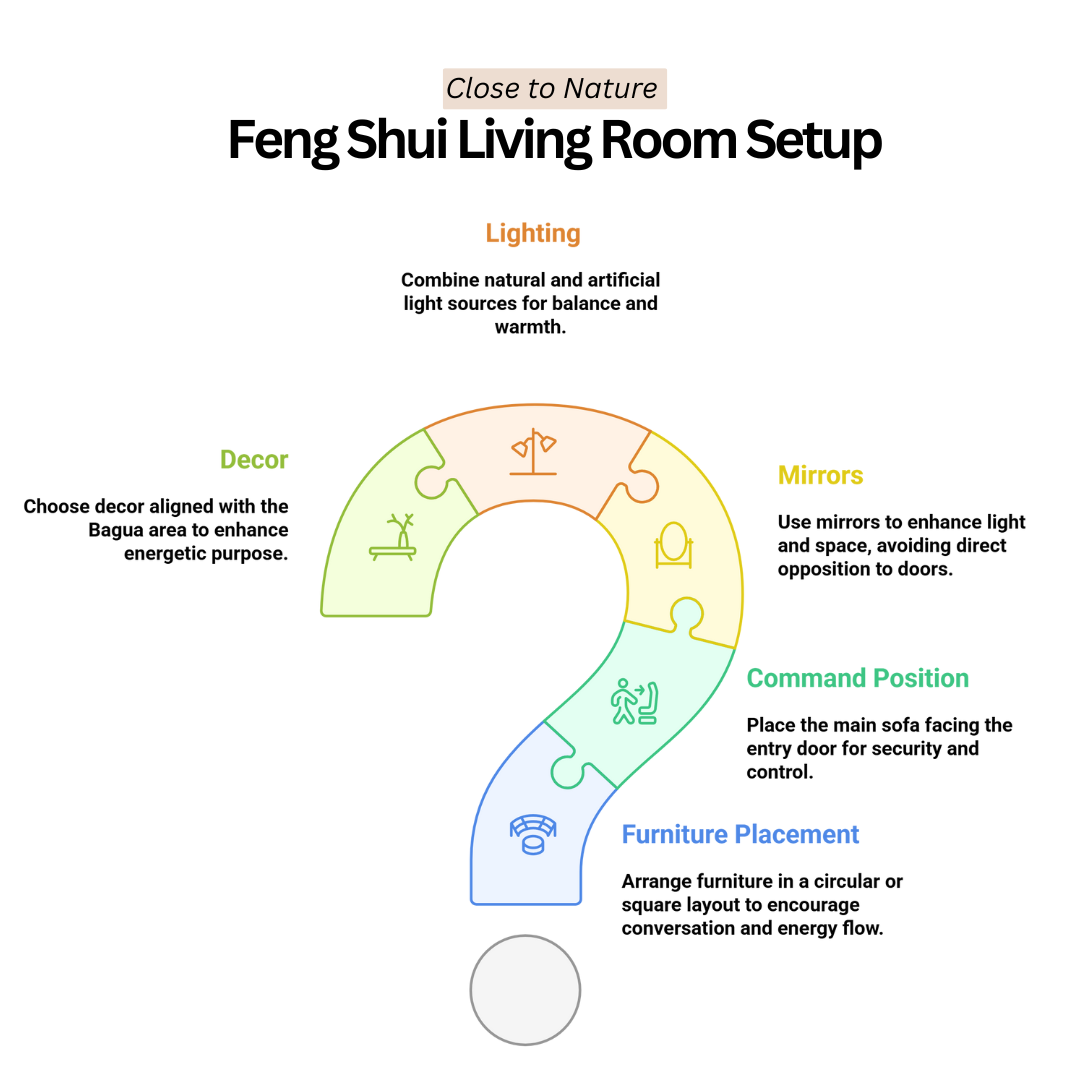
Feng Shui Bedroom Setup
1. Bed Placement
The bed should be in the command position—ideally diagonal from the door, but not directly aligned with it. A sturdy wall behind the headboard provides support and emotional stability.
Avoid placing the bed under windows, as this may cause restlessness. Ensure both sides of the bed are accessible, symbolizing balanced partnerships. Nightstands on each side promote equality and stability in relationships.
This layout supports restful sleep, emotional security, and intense personal energy. Proper bed placement is foundational for positive Feng Shui in the bedroom.
2. Avoid Mirrors Facing the Bed
Mirrors directly facing the bed can reflect energy, causing restlessness and interfering with intimacy. According to Feng Shui, they bounce energy around the room, disrupting the calmness needed for deep sleep.
Mirrors near the bed may also invite a third party into romantic relationships, symbolically. If a mirror cannot be moved, cover it at night with a cloth or curtain.
Mirrors should ideally be positioned to reflect light and beauty, not the sleeping area. Removing or repositioning them supports peace and deeper rest.
3. Minimize Electronics
Electronics such as TVs, phones, and computers emit electromagnetic fields (EMFs) that disrupt the calming energy of a bedroom. They contribute to mental stimulation and stress, counteracting rest and intimacy.
If removing them isn’t feasible, cover or unplug them during sleep. Avoid charging devices near the bed. Keep work-related electronics out of the room to separate rest from productivity.
An effective feng shui room setup minimizes electronics to reduce stress and electromagnetic interference, promoting a more peaceful and restorative environment.
4. Under-Bed Space
Avoid storing items under the bed to allow Qi to circulate freely around you during sleep. Clutter beneath the bed can trap stagnant energy and affect your subconscious.
If storage is necessary, choose soft items like extra linens rather than heavy or emotional objects. Ensure the bed frame is elevated enough for air and energy to move easily.
A clear under-bed area supports restful sleep, lightness, and mental clarity. This principle encourages both physical tidiness and emotional well-being in your sanctuary.
5. Soothing Colours
Choose bedroom colours that evoke peace and intimacy. Skin-tone-inspired hues such as soft cream, blush pink, peach, rose, and lavender create a calming and nurturing environment.
Avoid overly bright or stimulating colours like red or stark white. Gentle, warm shades promote relaxation and affection, making the bedroom feel like a true retreat.
Balance colours with textures—soft fabrics, plush rugs, and layered bedding—for sensory comfort. The right palette supports emotional healing, quality sleep, and a stronger connection with your partner and self.
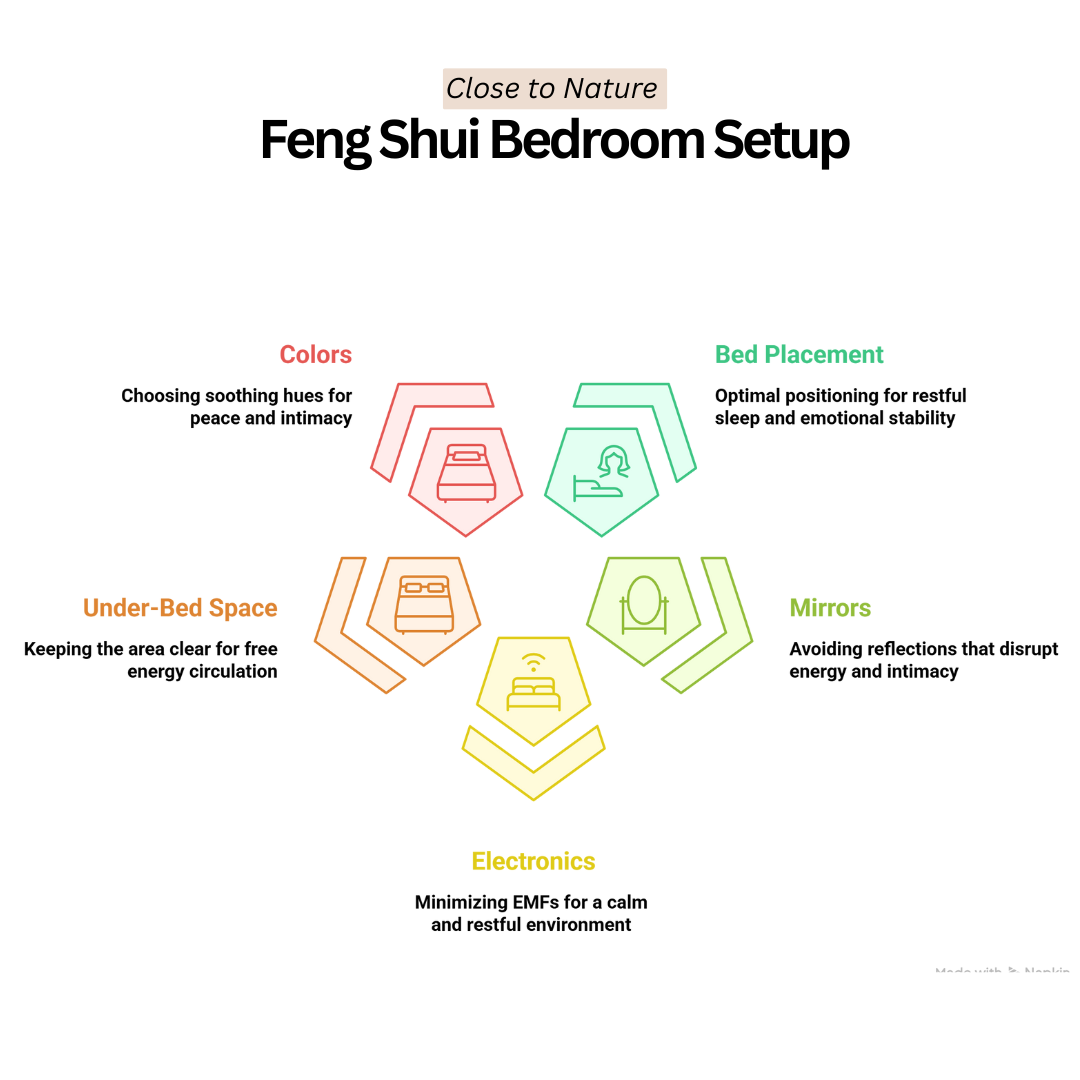
Feng Shui Kitchen Setup
1. Stove Position
The stove symbolizes wealth and nourishment in Feng Shui, so its placement is critical. Ideally, it should be in the command position, allowing you to see the entrance while cooking.
If this isn't possible, hang a small mirror behind the stove to reflect the door. This protects your energy and enhances abundance.
The stove should not be placed immediately across from the refrigerator or sink since the water and fire elements would conflict. Proper stove placement helps maintain balance, focus, and prosperity in the home.
2. Keep It Clean
A clean stove attracts prosperity and supports physical health. Grease buildup or unused burners signify neglected wealth and opportunity.
Clean all burners regularly and rotate their use to ensure energy flows evenly, promoting financial stability and personal vitality. Also, keep the oven and the surrounding area free of clutter.
In Feng Shui, cleanliness invites clarity and abundance, and the stove is a significant energetic hub. Treat it with care to maintain the health, warmth, and financial well-being of your household.
3. Colour And Elements
A balanced feng shui room setup incorporates all five elements—wood, fire, earth, metal, and water—to create harmony and support well-being, especially in spaces like the kitchen.
To harmonize the space, introduce the earth element using ceramic tiles, pottery, or earth-tone colours like tan, yellow, or ochre. Add wood elements with cutting boards or small plants to create a cycle of nourishment.
Metal tools and glassware bring clarity and precision. This elemental harmony fosters a nourishing, grounded, and balanced cooking environment.
4. Declutter Countertops
A clutter-free kitchen countertop promotes efficiency and allows Qi to circulate freely. Keep only daily-use essentials on display and store appliances when not in use.
Clean, open surfaces invite freshness and ease in food preparation, encouraging mindfulness and joy while cooking. Avoid piles of paper or miscellaneous items, which contribute to stagnation.
Organized drawers and cabinets contribute to the overall flow. Streamlined countertops not only improve functionality but also energetically support abundance, health, and nourishment for everyone in the home.
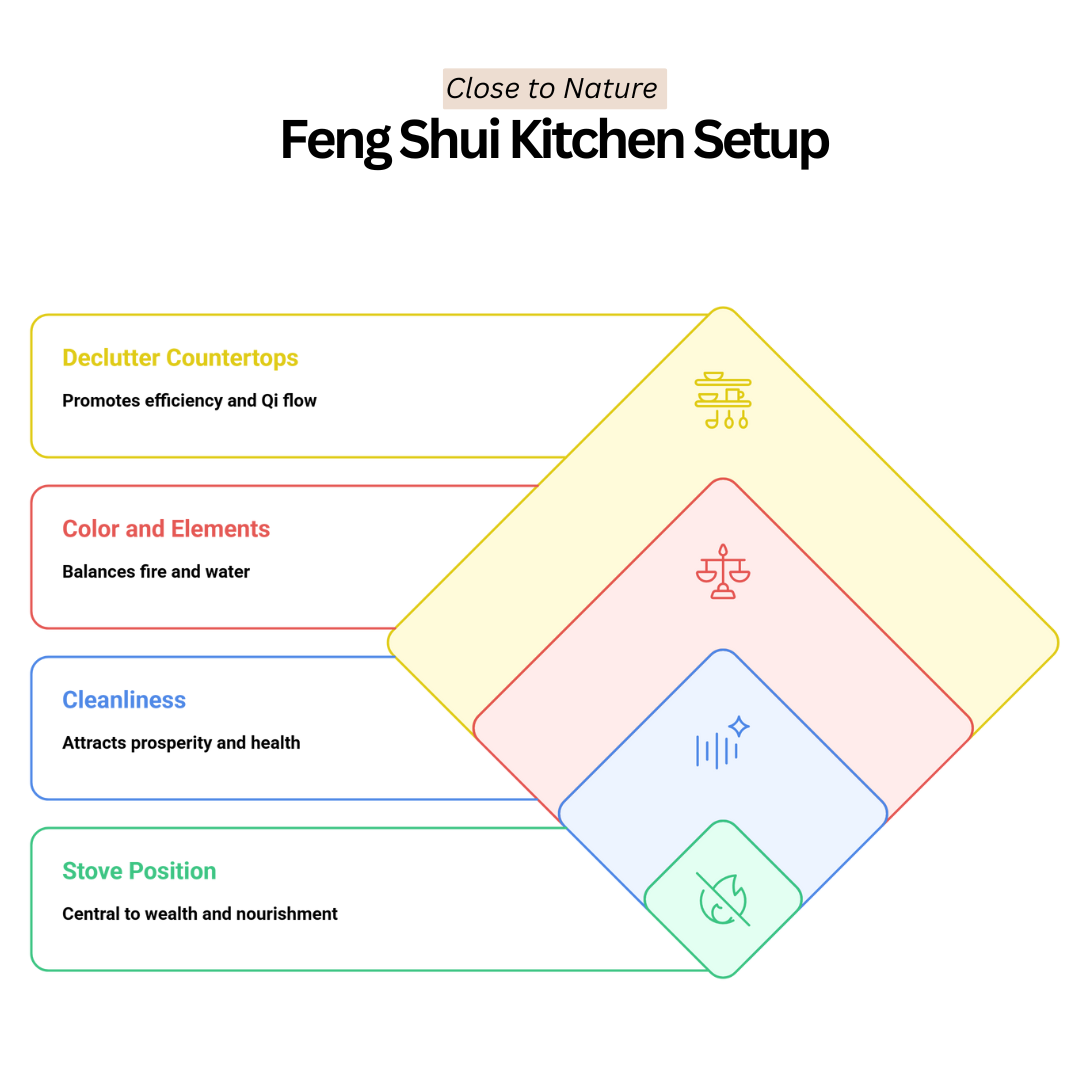
Feng Shui Office Setup
1. Desk Position
Your desk should be placed in the command position—facing the door but not directly aligned with it, and ideally with a solid wall behind. This fosters confidence, control, and strategic thinking.
Avoid having your back to a door or window, which can invite distraction and reduce focus. If necessary, use a high-back chair or screen for support.
Being in command enhances productivity, helps you feel grounded, and supports career growth. This simple adjustment can transform your workflow and mental clarity.
2. Clutter-Free Surfaces
A clear workspace allows creativity and productivity to thrive. In Feng Shui, clutter symbolizes mental blocks and missed opportunities.
Keep only essential tools, a few inspiring items, and organized documents on your desk. Daily cleaning prevents stagnation and boosts motivation. Personal items should support your professional goals, not distract from them.
Avoid food wrappers, excess cords, or unrelated materials. A clutter-free desk reflects a focused, purposeful mindset and encourages opportunities, flow, and mental clarity in your work environment.
Create a Profitable Holistic Business That Transforms Lives
🌿 Discover inspiring holistic business ideas that blend nature, wellness, and purpose.
Learn how passionate nature lovers are building income streams while helping others live more balanced, mindful lives.
Read Profitable Holistic Business Ideas That Transform Lives
3. Inspiration Board
Place a vision board or motivational quotes in the Fame (center back) or Career (front center) areas of your workspace according to the Feng Shui Bagua map. This energizes your intentions and keeps your goals visible.
Include symbols of success, achievements, or affirmations that uplift you. Avoid placing heavy or negative imagery, which can weigh down your mindset.
An inspiration board is a tool for direction and confidence, reinforcing your purpose. When positioned correctly, it supports ongoing progress and ambition.
4. Balance Elements
A well-balanced feng shui room setup includes all five elements to create a dynamic yet grounded environment that enhances focus, creativity, and overall well-being.
- Use wood for growth and creativity—think plants, books, or wooden shelves.
- Metal represents clarity and precision, so include metallic tools or organizers.
- Water enhances flow and communication; small fountains or blue tones work well.
- Add a candle or red accents for fire energy and passion.
- Earth elements like crystals or pottery add stability.
This elemental balance keeps your energy dynamic yet grounded, improving productivity and well-being.
5. Lighting
For a Feng Shui office, adequate illumination is crucial. Your desk should be placed next to a window since natural light improves vitality and mental clarity. Use warm-toned desk lamps to reduce eye strain and maintain alertness.
Avoid harsh, fluorescent lights that create stress. If there is a shortage of natural light, think about using full-spectrum bulbs to simulate sunlight.
Keep windows clean and curtains open during the day. Balanced lighting uplifts mood, improves focus, and enhances the energetic flow in your workspace for greater success.
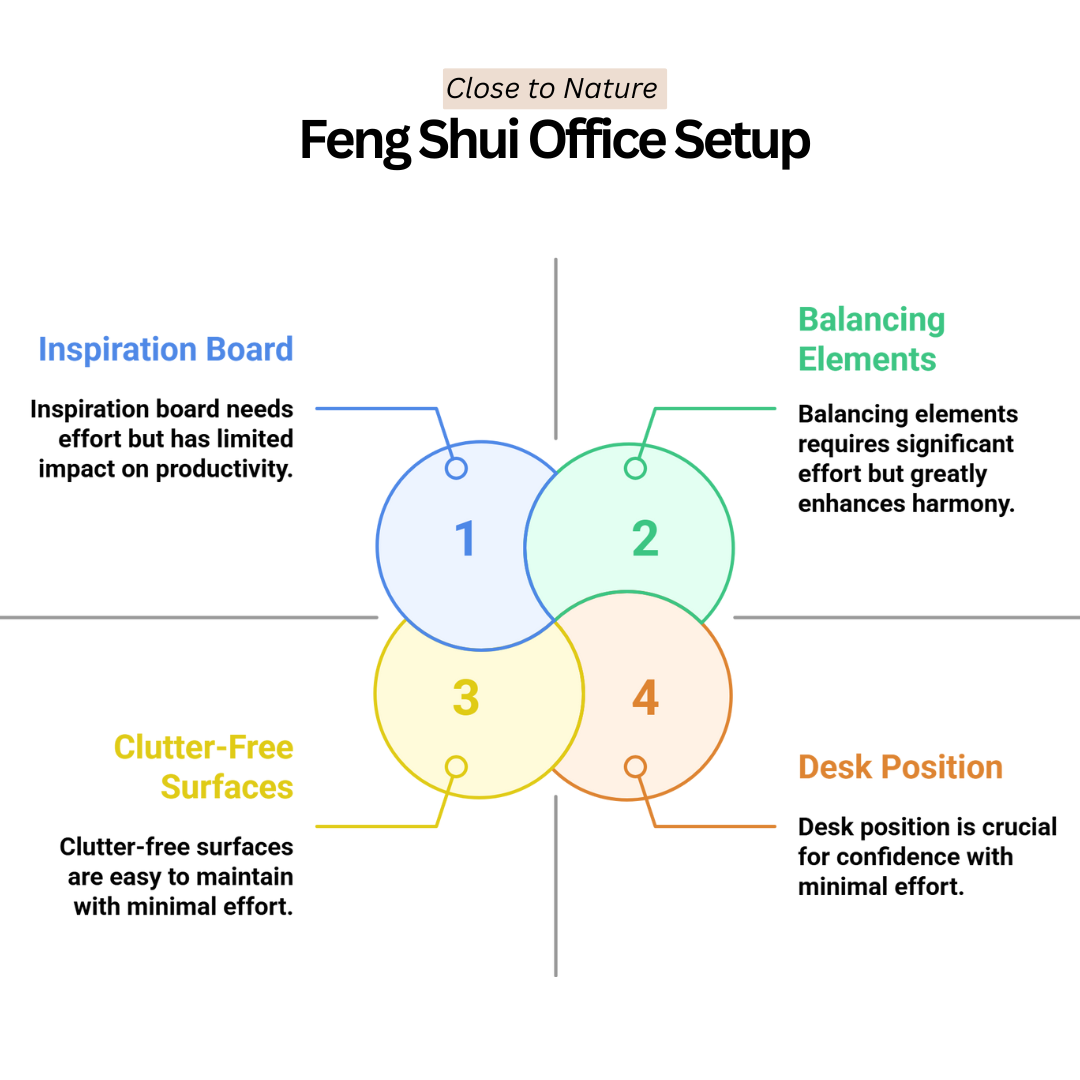
Feng Shui Bathroom Setup
1. Keep Doors Closed
Bathrooms are seen as energy drains in Feng Shui due to their plumbing systems. Always keep the bathroom door and toilet lid closed to prevent Qi from escaping.
This simple habit contains energy and protects the prosperity of your home. If a bathroom is near the front door or kitchen, it's even more important to be mindful.
Add a small rug or mat to anchor energy and ensure the space feels secure. This practice supports health, stability, and overall energy retention.
2. Use Earth And Wood
Bathrooms have an overwhelming water element, which can lead to emotional imbalance. To stabilize this, incorporate the earth element with stone décor, pottery, or beige and brown tones.
Wood elements like bamboo accessories, wooden shelving, or plants bring vitality and upward energy. These additions counterbalance excess water and promote calm, wellness, and nourishment.
Avoid too much black or blue, which increases water energy. A balanced element scheme in the bathroom encourages grounding, harmony, and protection against energy loss.
3. Mirrors And Light
Well-placed mirrors and good lighting uplift the energy in bathrooms. Use mirrors to reflect beauty and light, but avoid placing them where they reflect the toilet, which can magnify draining energy.
Combine natural light with soft artificial lighting to prevent shadows and brighten the space. Keep mirrors clean and in good condition to maintain clarity.
Choose attractive frames to add stability and containment. Thoughtful lighting and mirrors not only enhance the bathroom’s functionality but also preserve uplifting Qi in the space.
4. Clean And Fresh
A clean and fresh space is essential for a feng shui room setup, as it clears stagnant energy and supports emotional balance, clarity, and overall vitality.
Bathrooms should be spotless—free from grime, mildew, or foul odours. Ensure proper ventilation to keep air moving and use natural scents or essential oils to freshen the energy.
Replace worn-out towels or bathmats regularly. A fresh bathroom supports clarity, self-care, and wellness. Cleanliness in Feng Shui is not just about appearance—it reflects energetic hygiene and directly affects your vitality and emotional balance.
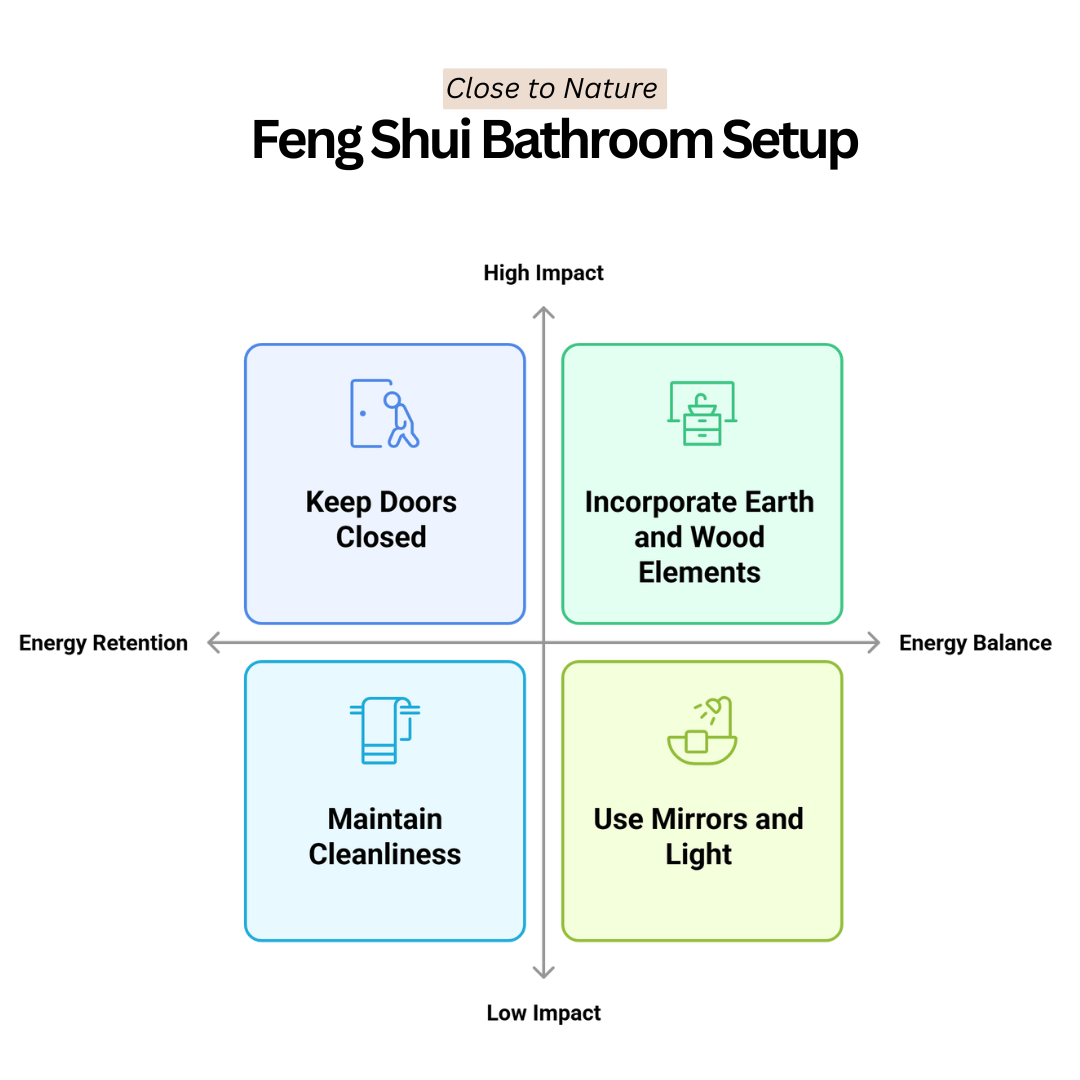
Feng Shui Entryway Setup
1. Clear Path
The entryway is known as the “mouth of Qi,” where energy enters your home. Keep this area clutter-free and easy to navigate, with no shoes, coats, or boxes blocking the doorway.
Make sure the front door opens fully and doesn’t squeak or stick. Good lighting and open space help attract positive energy and ensure it flows smoothly inside.
A clean, clear path invites opportunities and harmony. Your entryway’s condition significantly influences the energy that permeates your home and your life.
2. Use A Rug Or Mat
In a feng shui room setup, using a rug or mat at the entrance helps invite positive energy and creates a welcoming, grounded transition into your space.
Choose one with a cheerful design or a meaningful symbol to set an uplifting tone. A round or oval mat can soften sharp corners, while earthy colours ground the energy.
Clean it regularly and replace it if worn. Rugs also help define the space and create an intentional threshold between outside and inside. This simple addition encourages a smooth, welcoming, and protective energy transition.
3. Mirror Placement
Mirrors in the entryway can expand light and make the area feel more spacious, but placement is crucial. A mirror that faces the front entrance should not be placed there because it reflects energy outward, snuffing out opportunities.
Instead, hang a mirror on a side wall to redirect and amplify positive Qi. Use a beautiful, framed mirror and keep it clean.
This thoughtful placement supports balance, enhances visibility, and invites positive energy deeper into your home rather than allowing it to bounce back out.
4. Add Plants Or Symbols
Healthy plants near the entryway uplift the space and symbolize growth and vitality. Choose low-maintenance varieties like jade plants or bamboo for luck and resilience.
You can also add wind chimes, meaningful art, or symbols that represent protection and prosperity. These items activate and energize the entry while making it feel personalized and intentional.
Avoid dead plants or broken décor. A vibrant, well-cared-for entryway sets a positive first impression and ensures intense, healthy energy enters and nourishes your home.

Feng Shui For Small Spaces
1. Multifunctional Furniture
In small spaces, choosing multifunctional furniture is key to maintaining energy flow without clutter. Pieces like sofa beds, storage ottomans, or foldable tables maximize usability while conserving room.
However, avoid overcrowding the space with too many items, even if they serve multiple purposes. Overly tight arrangements restrict Qi and create stagnant energy.
Leave enough breathing room for movement. Thoughtfully selected, multifunctional furniture keeps the space efficient, comfortable, and energetically balanced without feeling cramped or overwhelming.
3. Vertical Space
In a feng shui room setup, using vertical space with shelves or tall décor encourages upward energy flow and makes the room feel more open and uplifting.
Installing shelves or tall bookcases draws the eye upward, creating a feeling of spaciousness and lightness. Display meaningful, uplifting objects or plants on these shelves to boost positive energy.
Avoid cluttering vertical surfaces with too many items, which can overwhelm and weigh down the space. Vertical organization balances horizontal limits and helps your small room feel expanded, supported, and more energized.
4. Use Mirrors Wisely
Mirrors can be powerful tools to visually enlarge small spaces by reflecting light and opening perspectives. Place mirrors to reflect beautiful views or light sources, but never let them reflect clutter, sharp corners, or chaotic areas, as this doubles negative energy.
Clean, framed mirrors add clarity and a sense of depth, making the room feel larger and brighter. Thoughtful mirror placement enhances energy flow, amplifies positive vibes, and creates a harmonious, spacious atmosphere even in compact living areas.
5. Keep It Light
Bright colours and airy fabrics significantly uplift small spaces in Feng Shui. Choose light wall colours such as soft whites, creams, pastels, or gentle earth tones to open the room visually and energetically.
Use sheer curtains that let natural light flow freely, avoiding heavy drapes that block sunlight. Minimal décor helps prevent clutter buildup, allowing Qi to circulate unhindered.
Incorporating these elements creates an inviting, spacious, and vibrant atmosphere, making even the smallest space feel refreshing and energetically balanced.

Conclusion
A mindful Feng Shui Room Setup can genuinely transform your home into a sanctuary of peace and positive energy. You can design an environment that promotes happiness and supports your well-being by putting these easy suggestions into practice.
Remember, the key is balance and intention. Begin your adventure now and take pleasure in the long-term advantages of a peaceful setting created just for you.
I trust you enjoyed this article on the Easy Feng Shui Room Setup Guide. Please stay tuned for more inspiring guides, helpful tips, and ideas to help you live closer to nature every day.
Take care!
— JeannetteZ
💬 Your Opinion Is Important To Me
Do you have thoughts, ideas, or questions? I’d love to hear from you. Please leave your comments below or email me directly at Jeannette@Close-To-Nature.org.
📚 More Nature-Inspired Reads
Explore more ways to connect with nature, nurture your pets, and live in harmony with the world around you 🌿

